Chicken schnitzel are chicken breasts that have been flattened, coated with breadcrumbs and fried. It's a popular dish in German cuisine and is typically served with a side of potatoes. Chicken schnitzel are like giant chicken nuggets. What's not to like?
Tenderised chicken pieces are dredged in seasoned flour, eggs and finally panko breadcrumbs. They are then shallow-fried until golden brown. It's the combination of dry-wet-dry coatings that creates the ultimate in crunch and texture. Chicken schnitzel are crispy on the outside, juicy and tender on the inside.
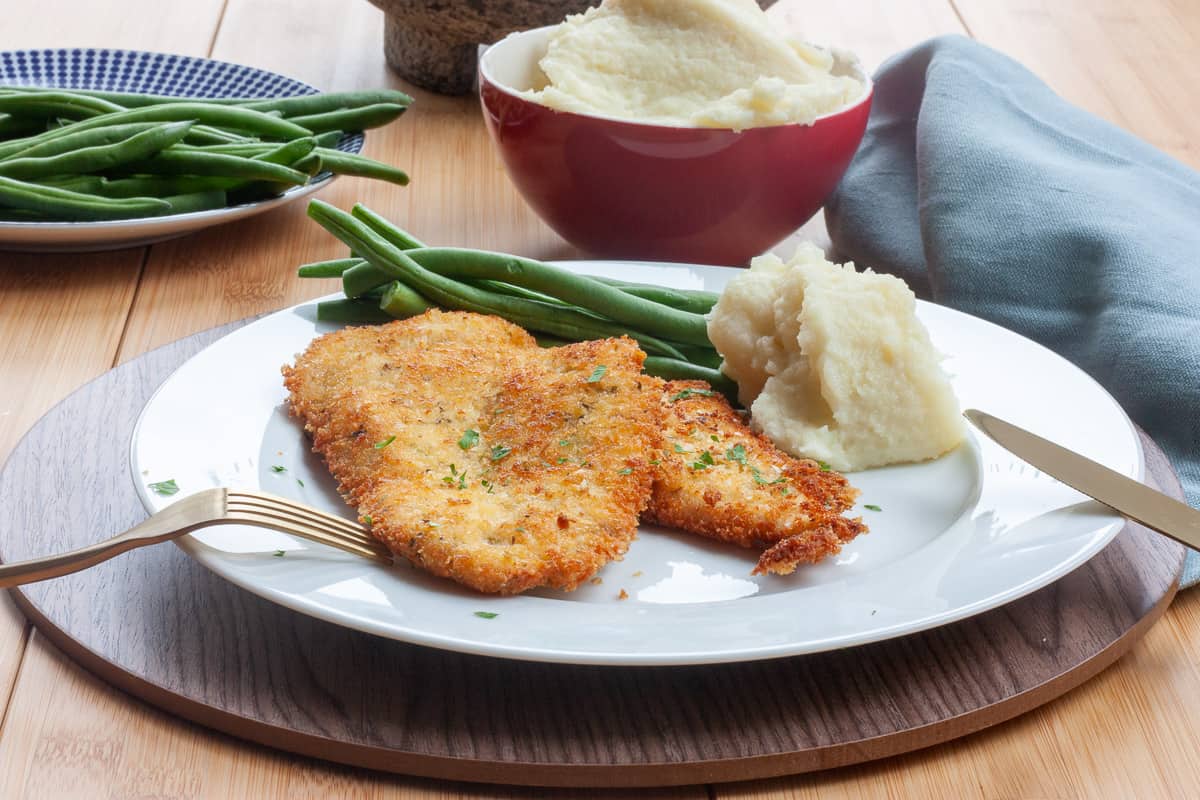
These are great to have in the fridge. I love snacking on them cold, my husband thinks I'm weird. Always make extra. Just microwave to reheat (if you need to eat them hot of course). They won't be quite as crispy, but they're still really good.
As with most fried foods, chicken schnitzels are great served with a touch of something tangy and acidic. A squeeze of fresh lemon juice, some English mustard or tomato ketchup. Creamy soft mashed potato is a great contrast to the crispy chicken.
Jump to:
🥘 Ingredients

Chicken Breast - boneless chicken breasts are perfect for chicken schnitzel. They have uniform texture and can be worked into relatively thin large pieces. There aren't many instances where chicken breasts are better than other cuts such as thighs (IMO). This is one of them.
Flour - dredging chicken fillets in flour gets rid of any extra moisture. This helps us achieve crispy results. Flour also helps the egg mixture adhere to the chicken.
Eggs - dipping the chicken in beaten eggs ensures that the breadcrumbs don't fall off.
Breadcrumbs - the final coating provides the crispiness of the schnitzels. Panko (a type of readily available Japanese breadcrumb) is the go-to for schnitzel. It's processed from crustless bread into large flakes, rather than crumbs. The coarser texture gives panko a lighter, airier texture than most other breadcrumbs.
Dried Oregano - some is mixed through the breadcrumbs to add a touch of Italian seasoning. This could easily be substituted or left out, depending on what flavours you're into.
Olive Oil - tastes the best! We only need the oil to come halfway up these (thin) pieces of chicken and we cook in batches. We don't need too much.
💩 Is this recipe low FODMAP?
The jury's out on this one for now. There is minimal wheat flour per portion (less than 20g). Not all the suggested flour for dredging the chicken breasts gets used. The Monash University FODMAP diet app at present doesn't state if this amount is low enough. It only states that 100g is high in FODMAPs. Interestingly, the amount of Panko in this recipe (less than 40g per portion) is deemed low FODMAP. The main ingredient in Panko is, you guessed it, wheat flour. So...I believe this recipe is low FODMAP, but it won't be found in my low FODMAP recipe category until I can say for sure.
Substituting the plain flour with cornflour/starch and using gluten-free breadcrumbs would work fine, if you want to follow this recipe. Use the same quantities.
🔪 Instructions
We cut each chicken breast into three parts before flattening out with a tenderiser. We get a tenderloin and two larger pieces.
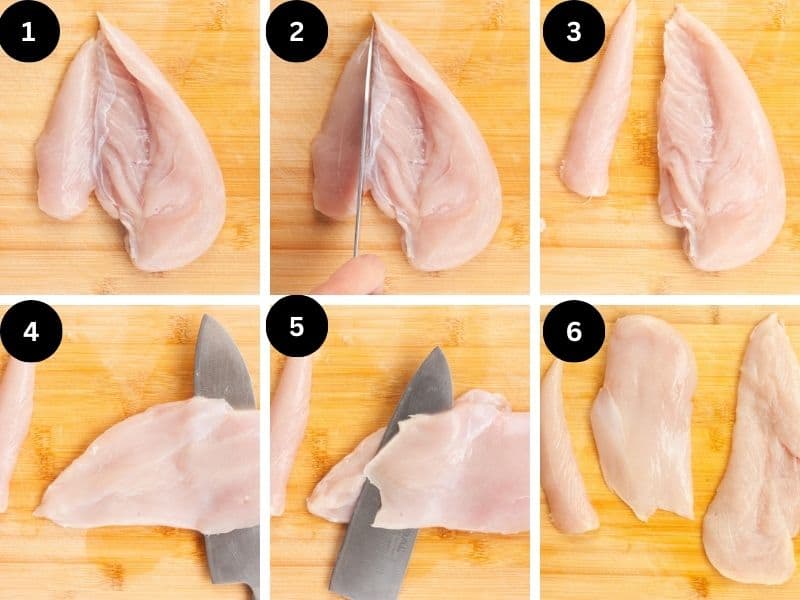
(Photo 1-3 above) locate the tenderloin. It's a small tear-shaped flap attached to the main part of the chicken (one per breast). Open like a book away from the rest of the breast and cut along the join to separate them. Sometimes this is covered with a thin membrane that can be trimmed away. Set the tenderloin aside.
(Photo 4 & 5 above) press your flattened hand down on top of each chicken breast. Slice parallel to your hand through the middle of the breast. One end of the wedge is thinner - you may want to leave that part unsplit (ie. the two 'halves' might not be the same size).
(Photo 6 above) for each breast, you will end up with three pieces of chicken. A tenderloin, medium-sized fillet and a large fillet. Repeat for the remaining two chicken breasts.
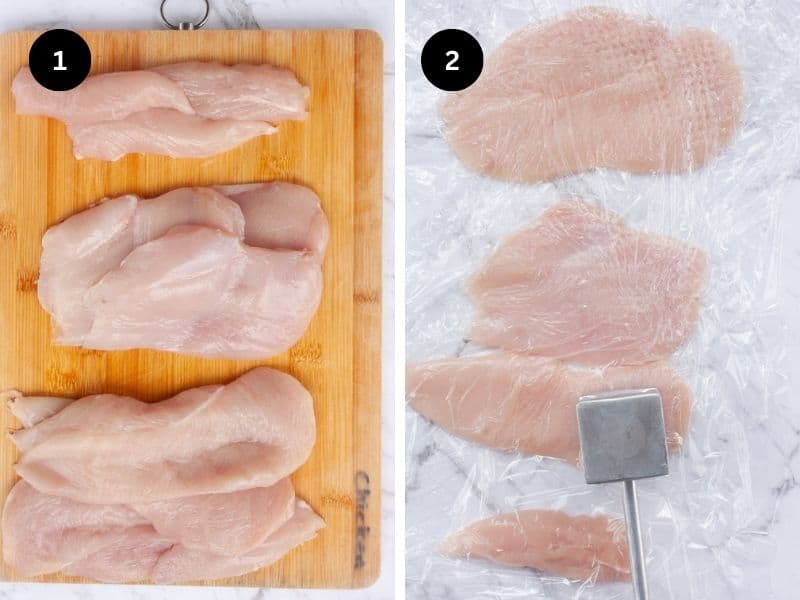
Once we have our portions of chicken prepared, we tenderise them with a mallet. This serves three purposes:
- creates thinner and flatter chicken pieces
- breaks down the fibres and connective tissue in the meat, making it more tender
- means you can make the chicken uniformly thin across each piece
I have a mallet with a smooth surface on one side and a spiky surface on the other. I use the spiky end. Laying the chicken between plastic wrap ensures we don't pierce the meat and tear it.
You may not need to tenderise all parts of the meat if they're already thin. For any thicker sections; let the weight of the mallet do its thing rather than hammering it down. You're aiming for roughly equal thickness throughout, about ½ cm. The schnitzels thicken up on cooking.
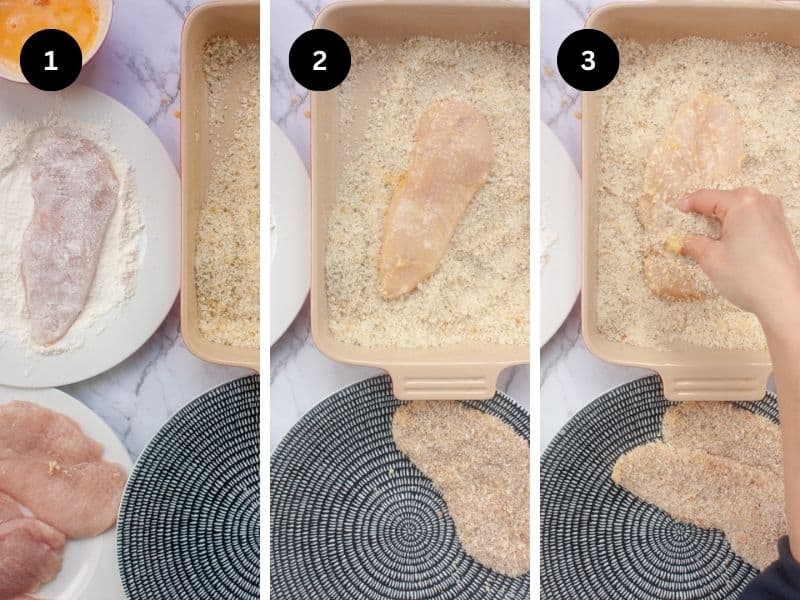
Now that our chicken pieces are ready to coat, let's get our toppings ready and in a logical order:
- seasoned flour
- eggs - whisked well to minimise stringy bits, which tend to clump to the chicken and make the coating uneven and a bit messy
- panko breadcrumbs with oregano mixed through
(Photo 1 above) press each chicken slice into the flour, turning to coat both sides. Lift up and pass between your palms to dust off the excess.
(Photo 2 above) after dunking in the egg and allowing the excess to drip off, place in the panko.
(Photo 3 above) pick up more breadcrumbs and lay them on top. Press down with your palms to press the crumbs in and help them stick. Gently pick up the chicken and allow the excess breadcrumbs to fall away. Lay it on a plate. Repeat with the rest of the chicken.
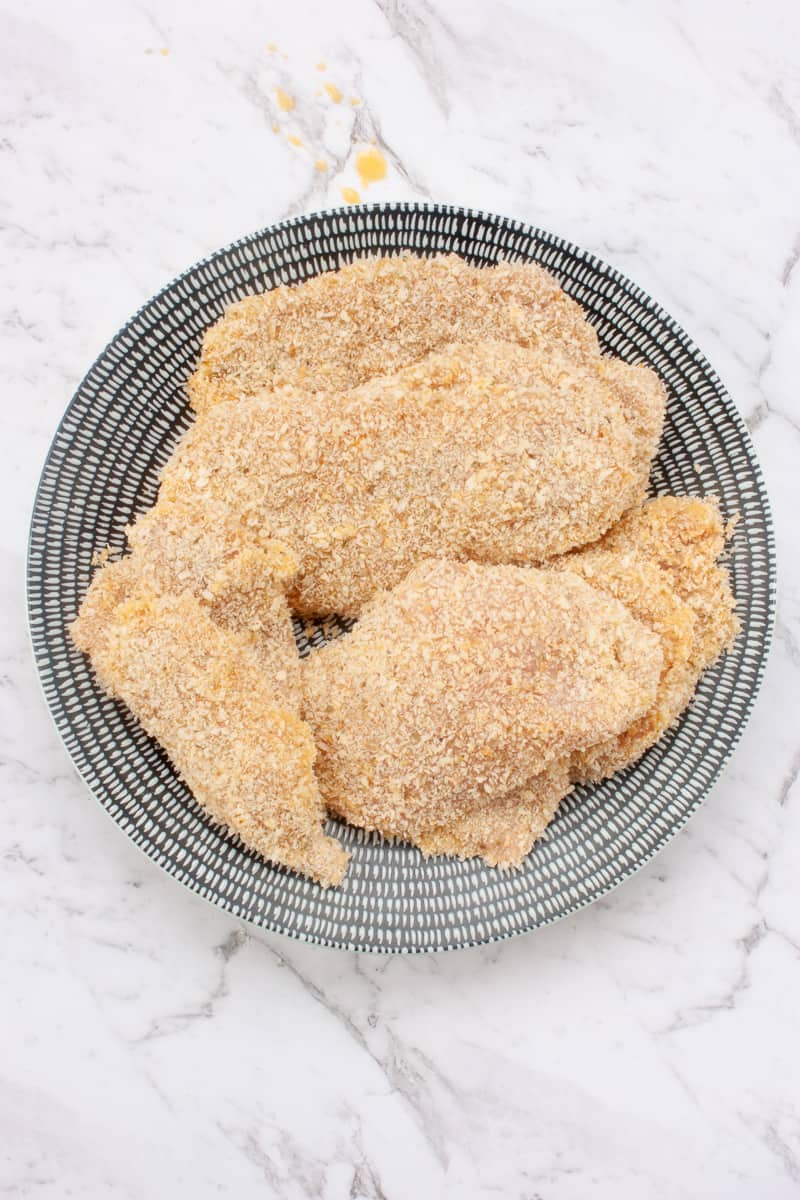
Heat up enough oil in a large frying pan to come halfway up the sides of the chicken schnitzel. Try to keep the heat on a consistent medium temperature. Heat until, when you throw in a few breadcrumbs, they gently sizzle on contact with the oil.

(Photo 1 above) Slowly lay in two or three of the larger schnitzels (don't overcrowd the pan), so that the edge furthest away from you goes in last. This helps avoid any oil splashes. Allow to cook for a couple of minutes.
(Photo 2 above) You'll know when the schnitzels are ready to turn when the edges are golden-brown and crisp. You can gently lift a piece and peek underneath. We want them to be beautifully browned. The chicken will go in floppy and firm up as they cook.
Some oil is absorbed during the cook. Thus, I recommend starting with the largest pieces first. There will be enough oil left to cook the smaller (and usually thinner) pieces after.
Transfer cooked schnitzels to a plate lined with paper towel first to allow any excess oil to drain off. Sprinkle generously with salt while they're still really hot.
Ideally, we don't top up the oil during the cook. We'll end up with unevenly heated oil and will need to wait for it to come up to temperature again.
If you want to batch up, you can reuse the oil. However, it will be worth straining the oil to get rid of any loose breadcrumbs that will burn. You will need to top up the oil with a little more.
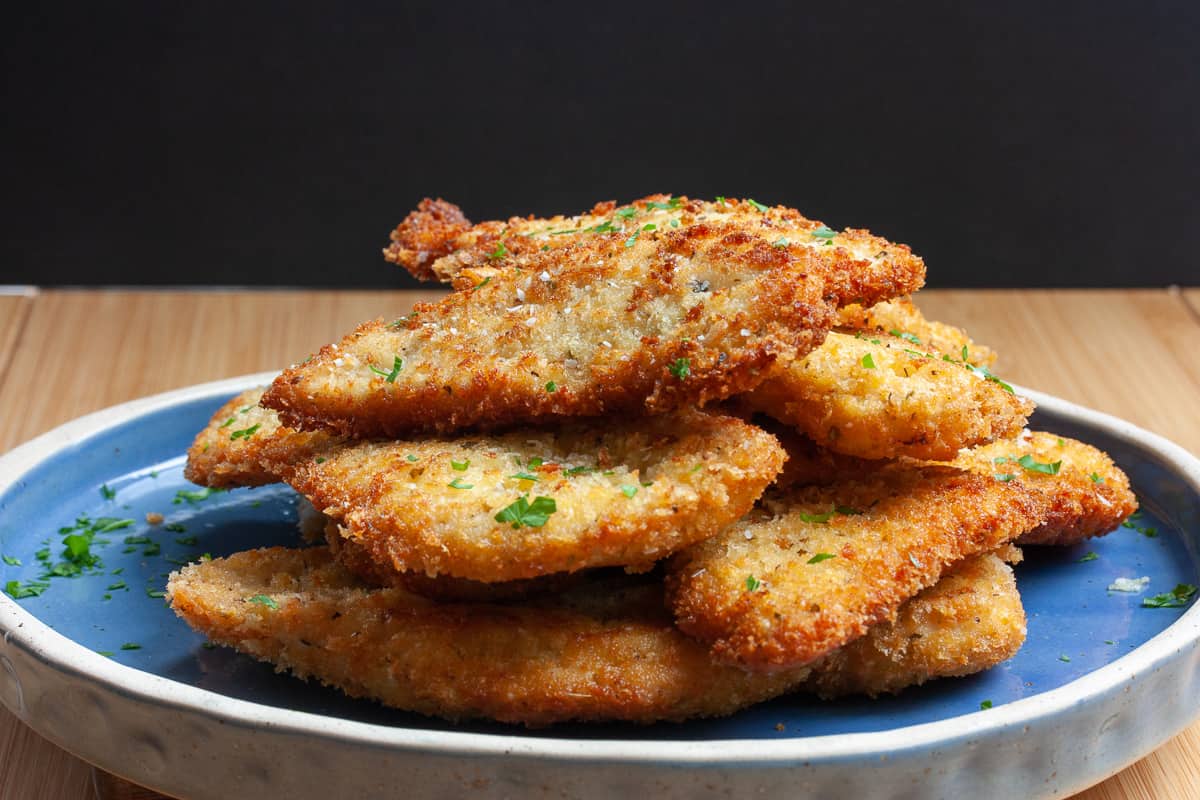
📖 Recipe
Equipment
- large frying pan
Ingredients
- 3 chicken breast fillets
- 70 g plain flour
- salt
- freshly ground black pepper
- 3 eggs
- 150 g panko breadcrumbs
- 2 teaspoons dried oregano
- olive oil (for shallow frying)
Instructions
Prepare Chicken
- Trim Fat - remove any excess fat without cutting into the breasts.3 chicken breast fillets
- Remove Tenderloins - locate the tenderloin. It's a small tear-shaped flap attached to the main part of the chicken (one per breast). Open like a book away from the rest of the breast and cut along the join to separate them. Sometimes this is covered with a thin membrane that can be slipped off. Set the tenderloin aside.
- Split Breast - press your flattened hand down on top of each chicken breast. Slice parallel to your hand through the middle of the breast. One end of the wedge is thinner - you may want to leave that part unsplit (ie. the two 'halves' might not be the same size). For each breast, you will end up with three pieces of chicken - a tenderloin, medium large fillets. Repeat for the remaining three chicken breasts.
- Tenderise Chicken - lay some pieces between two sheets of plastic wrap. Using a meat tenderiser or rolling pin, lightly pound the chicken. Aim for a consistent thickness across each piece of around ½ cm. Some sections will need more attention than others. Transfer the chicken pieces to a plate. Repeat until all the chicken is tenderised.
Prepare Coating
- Flour Dredge - in a small bowl, combine flour, ¾ teaspoon salt and black pepper. Tip out onto a plate big enough to lay the biggest chicken pieces flat.70 g plain floursaltfreshly ground black pepper
- Eggs - whisk the eggs into a bowl big enough to dunk the largest chicken piece. Whisk well so that there are no stringy bits.3 eggs
- Breadcrumbs - place Panko in a dish with sides, big enough to lay the biggest schnitzels flat. Mix through oregano, ¼ teaspoon salt and some black pepper.salt150 g panko breadcrumbs2 teaspoons dried oreganofreshly ground black pepper
- Assembly Line - line up the coatings in the order they will be applied - the flour plate, then the egg bowl, the panko. Lastly, have an empty plate ready to take the prepared schnitzels
Make Schnitzels
- Apply Toppings - press a chicken portion into the flour on both sides. Pass between your hands to shake off any excess flour. Holding minimally at one end, dunk into the egg, checking both sides to make sure the whole piece is wet. Let any excess egg drip back into the egg bowl. Lay the wettened chicken fillet into a bed of panko. Pile more panko over the top, press down with the palm of your hand, lift and shake excess off. Transfer to the empty plate. Repeat with the rest of the chicken fillets. You might find it helpful to pile similarly-sized pieces on top of each other. This will make it easier to arrange in the frying pan.
- Shallow Fry - use a large frying pan set over medium heat. Add enough oil to come at least halfway up the sides of the thickest chicken slice. Test a few crumbs of bread to see when the oil is hot enough; they should sizzle gently as soon as they hit the oil. Starting with the largest chicken pieces, fry for about 1 ½ minutes each side. Lay them in the oil moving away from you. Once cooked, lay on paper towel to allow excess oil to drain off and sprinkle with salt while still hot.olive oil



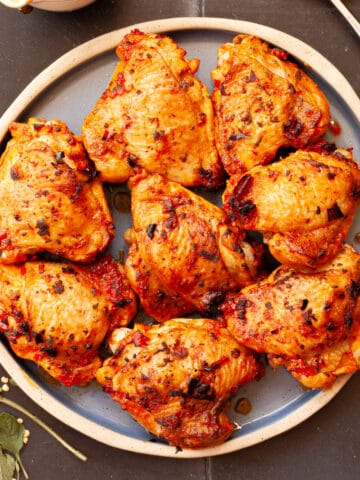
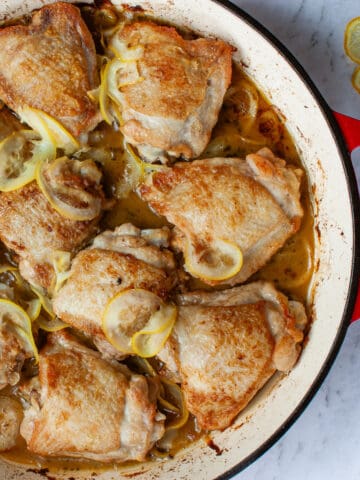
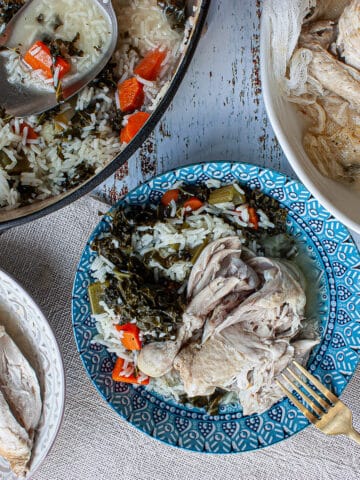
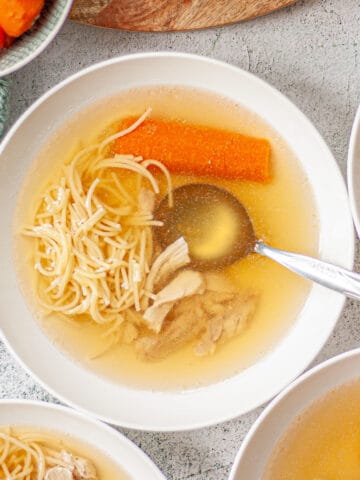
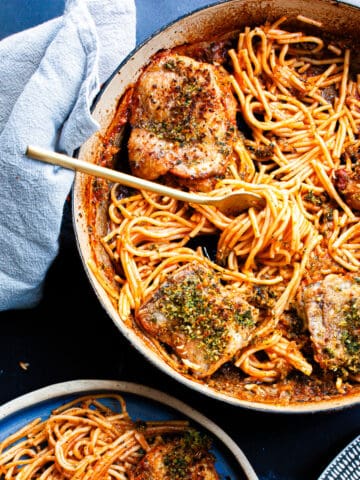


Comments